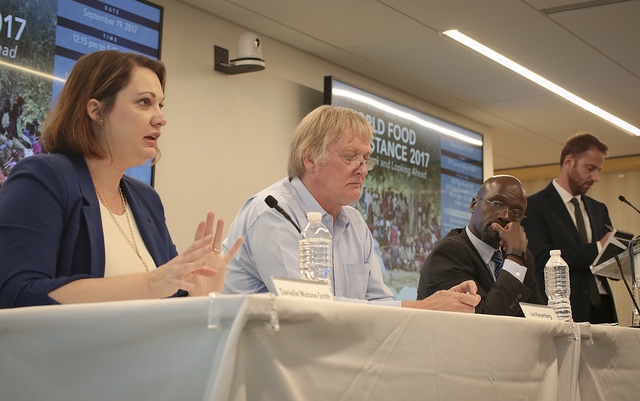Between 2009 and 2016, World Food Programme (WFP) spending on food assistance increased from $2 billion to over $5 billion as it responded to a series of humanitarian disasters. Many challenges remain in ensuring such assistance reaches its intended recipients, according to participants at IFPRI’s recent launch event for the WFP report, World Food Assistance 2017 – Taking Stock and Looking Ahead.
Food assistance plays a critical role as a bridge between humanitarian action and hunger reduction, said Steven Were Omamo, the WFP’s Deputy Director of Policy and Programme and Coordinator of Food Systems Strategy, Policy and Support, in summarizing the report’s findings.
But delivering it effectively is difficult, Omamo said. It depends on a country’s stability, the performance of food systems, income levels, and access for organizations and those in need. Apart from the total amount of aid they receive, individual countries’ performance in these areas varies widely. For instance, expenditures per direct beneficiary stood at $5 in Zambia and over $200 in Lebanon in 2015, Omamo noted. If countries systematically improved access, the report argues, the costs of delivering food assistance would be notably lower; WFP spending would be $1 billion less.
To improve the delivery of food assistance and help create more resilient food systems, capacity building efforts can be expanded beyond training individuals to include building institutions and policy systems, said Suresh Babu, Head of Capacity Strengthening at IFPRI.
Effective policies depend on sound data, Babu said, but current methodologies used by various countries to assess how many people are in chronic or acute food insecurity situations are vulnerable to data manipulation. He urged the development community to consider how to independently assess these numbers rather than accepting government-issued figures.
Lamenting the frequency of recent humanitarian disasters such as Hurricanes Irma and Maria in the Caribbean, mudslides in Sierra Leone, and earthquakes in Mexico, Lex Kassenberg, Senior Director of the Humanitarian Team at CARE USA, said that one of his organization’s biggest challenges is having to devote resources to responding to crises rather than to emphasizing the prevention or mitigation of them. But it is severe conflict, he said, that has the most significant impact on CARE’s programming. It is no coincidence, he noted, that current famines are all occurring in conflict-ridden areas.
“How do we do resilience in conflict settings?” asked Danielle Mutone-Smith, Head of Policy, Partnerships, and Communication at USAID/Food For Peace (FFP). As the largest food assistance donor in the world, she said, FFP remains hindered by the barriers and burdens of delivering food assistance. Access poses problems not only in terms of cost but also for the safety of workers, partners, and beneficiaries.
WFP’s flexibility in the modalities it uses to respond to emergencies is critical in jumpstarting recovering markets and providing beneficiaries with more choices, Mutone-Smith said. FFP’s own data has shown that there is no single “correct” approach to emergency assistance.
Kassenberg praised the WFP’s increased use of cash based transfers, which grew from less than 1 percent of its $2 billion in food assistance outlays in 2009 to over 20 percent of $5 billion in 2016. Cash transfers, he said, help CARE get the right kind of assistance to individuals and support local markets; when distributed using mobile phone apps, they reduce accounting errors by 95 percent and improve efficiency.
Given the 40 percent shortfall between WFP’s assessed financial needs and money mobilized in 2016, Omamo reiterated the importance of the report’s recommendations, including the need to invest in high quality food assistance programs; stabilize, increase, and unleash humanitarian funding; and fill vast data gaps. Such changes are essential if food assistance is to benefit the many who rely on it.
Katarlah Taylor is a Senior Events Specialist at IFPRI.







